Greek Gods
Greek Deities
In their effort to explain various natural phenomena, the ancient Greeks, those great storytellers who were distinguished for their endless sense of humor and unrestrained imagination, wove an infinite number of myths (a number of them possibly possessing a historical core), thus creating one of the most profound mythologies to have ever existed.
Their inquisitive mind, in a ceaseless quest for the cause of everything, also dealt with the creation of the world (Cosmogony) and the birth of their countless gods (Theogony). With their rich imagination, they built enormous genealogies to prove the ancestry of the ancestors of the twelve Olympian gods and all of the lesser ones, worshipped throughout Greece.
They also shaped amazing myths explaining how Zeus and the other Olympian gods gained absolute power within the Greek pantheon through the Battle of the Titans (Titanomachy) and how they managed to maintain it through the Battle of the Giants (Gigantomachy)
Always in constant need to address the divine element and satisfy their religious feeling, they constructed impressive temples and oracles in which to pray, perform their rituals and establish communication with their Protectors. Occasionally, they formed inner religious circles or mystic cults that partially deviated from common beliefs while playing an initiating role.
The Olympians are the twelve Goddesses and Gods who reined over heaven and earth. Zeus was the leader and the others were Hera, Poseidon and Demeter, his sisters and brother, and Ares, Hermes, Apollo, Artemis, Hephaestus, Dionysus, and Aphrodite (more often born from the sea), who were his children.
The Olympian gods gained power by defeating the Titans in Titanomachy. In fact, the ancient Greeks did not have a particular twelve, but there were great and smaller gods and others who were worshiped locally, for example Zeus, Poseidon, and Hades were the greatest gods, while Dionysus was a smaller god.
Gods and Goddesses
- OLYMPIAN GODS
- TITANS
- UNDERWORLD GODS
- PRIMORDIAL GODS
- SEA GODS
- SKY GODS
- RUSTIC GODS
- AGRARIAN GODS
- DAEMONES
- DEIFIED MORTALS
OLYMPIAN GODS
- Aphrodite
- Apollo
- Ares
- Artemis
- Athena
- Demeter
- Dionysus
- Hephaestus
- Hera
- Hermes
- Poseidon
- Zeus
TITANS
- Cronus
- Oceanus
- Iapetus
- Hyperion
- Crius
- Coeus
- Rhea
- Tethys
- Theia
- Phoebe
- Themis
- Mnemosyne
MINOR TITANS
- Helius
- Selene
- Eos
- Leto
- Asteria
- Hecate
- Pallas
- Astraeus
- Perses
DAEMONES
- Dike
- Eris
- Eros
- Geras
- Hebe
- Hygeia
- Hypnos
- Lyssa
- Mnemosyne
- Nemesis
- Nike
- Peitho
- Phobos
- Plutus
- Poena
- Pothos
- Soteria
- Thanatus
NYMPHS
- Nymphai
- Aurae
- Dryades
- Hesperides
- Naiads
- Nereids
- Satyrs
- Tritons
HEROES and VILLIANS
- Bellerophontes
- Ganymede
- Heracles
- Pandora
- Pasiphae
- Perseus
- Phaethon
- Psyche
- Triptolemos
BESTIARY
1. SUB-BESTIARIES
- Dragons
- Giants
- Legendary Creatures
- Legendary Tribes
2.MONSTERS & CREATURES
- Centaurs
- Cerberus
- Cetea
- Chimera
- Giants
- Griffin
- Harpies
- Hippocamps
- Lernaean Hydra
- Gorgons & Medusa
- Minotaur
- Pegasus
- Satyrs
- Skylla
- Sirens
- Sphinx
- Tritons
- Typhoeus
- Labors of Heracles
GIANTS
- Alcyoneus
- Aloadae
- Antaeus
- Argus Panoptes
- Cyclopes
- Cyclopes
- Enceladus
- Geryon
- Gigantes
- Polybotes
- Polyphemus
- Porphyrion
- Talos
- Tityus
- Typhoeus
LEGENDARY CREATURES
- Amphisbaena
- Basilisk
- Catoblepas
- Griffin
- Harpies
- Leucrocotta
- Manticore
- Unicorn Horse
- Onocentaur
- Phoenix
- Sirens
- Yale
- Ethiopian Bull
- Indian Cetea
- Indian Dragon
- Ethiopian Pegasus
- Satyrides Satyr
- Tanagran Triton
LEGENDARY TRIBES
- Libyan Satyr & Aegipan
- Arimaspians
- Blemmyae
- Centaurs
- Cynocephali
- Gegenees
- Gorgades
- Hippopodes
- Machlyes
- Nuli
- Panotii
- Pygmies
- Sciapods
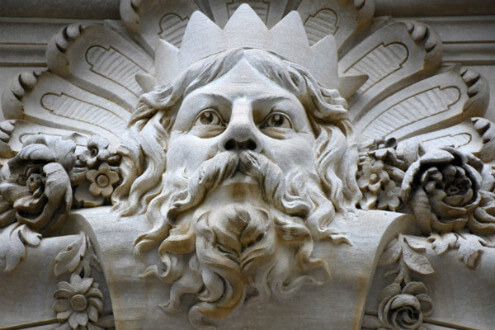
Zeus - ο Δίας - Jupiter
Zeus was the supreme god of Olympus – god of light, of the sky, of thunder and lightning.
Above this he was monitoring the order and justice in the world, being responsible for punishing the murderers and protecting the weak.
Zeus was the sixth son of the Titans Cronos and Rhea. Cronos was warned by an oracle that one of his sons will overthrow him, just as he did with his father Uranus. To prevent this, he swallowed all his five children born to Rhea. When Zeus became grown up enough, helped by the three Cyclopes (killed later by Apollon), Zeus released his brothers and sisters from the Cronos stomach (Demeter, Hades, Hestia, Hera and Poseidon), and together defeated his father and the Titans. The Cyclopes have Zeus the famous thunderbolts, and he was declared the supreme god. He divided the creation among Poseidon and Hades. Poseidon received the sea and Hades – the underworld. Zeus took the sky, being the main authority on earth and the mount of Olympus. So he remained the sovereign of the whole world, the mortals and the gods.
His attributes were: the thunderbolts, the shield, the scepter, sometimes the eagle.
People of the Brazen Age were doing many crimes, being arrogant and profane, they did not obey the Olympian gods. The Thunderer Zeus became angry at them, especially, he showed his anger on king Likaon. He came to him Lkosura as a mortal. He gave the inhabitants a sign, for them to know who he was and to honor him as God. Only Likaon didn’t want to praise Zeus and was jeered at those who did. Likaon decided to test if Zeus was the real God. So, he killed a hostage, half of whom he fried and half boiled, and put it on the table for Zeus. The Thunderer became very angry and destroyed the palace of Likaon by a thunderbolt, and converted Likaon into a wolf.
As the people became more impious, and Zeus decided to kill all the people. He sent on Earth such a strong cloudburst to sink everything. All the people and nature was destroyed, except those who built an ark. This was the Great Flood.
Greek God Zeus was the ruler of the Gods. His name Zeus was related to the Greek word “dios” which means light, lightning… Zeus was the Greek God of thunder, lightning, rain, storms…
Zeus was the youngest son of two Greek Titans, Cronus and Rhea. Since he knew of a prophecy that one of his sons will withthrow him, Cronus et all of his children as soon as they were born, so all of Zeus’s older brothers and sisters were eaten. Zeus’s mother Rhea talked with Titan Gaia about all this and decided to hide Zeus from his father. When Zeus was born she gave Cronus a rock wrapped in clothes, Cronus didn’t noticed and swallowed the rock thinking it’s his newborn son Zeus.
All his childhood God Zeus was hiding from his father and was raised by Titan Gaia, goat Amalthea and nymphs.
When he was grown up Zeus forced his father Cronus (with help of Titan Gaia) to release his older brothers and sisters, the Gigantes, the Hecatonchires and the Cyclopes, from their dungeon in Tartarus. After he released them, Cyclops gave him Thunder which Zeus used as his ultimate weapon.
Zeus then led other Greek Gods to the war against Titans that was called Titanomachy. Zeus, his brothers and sisters Gods, Cyclops Gigantes and Hecatonchires managed to win this war and to banish Titans deep into dungeons of Tartarus.
After achieving victory in Titanomachy, Zeus and his brothers Poseidon and Hades ruled whole world. Zeus became God of Sky and supreme ruler over the Gods and humankind, Poseidon God of Oceans and Seas and Hades God of the Underworld (The World of The Dead).
However the Titan Gaia who raised Zeus when he was a child was angry of what he has done to her children, other Greek Titans, and Zeus had to fight against Gaia’s soldiers and two giants Typhon and Echidna, also children of Titan Gaia.
Zeus had many children with Goddesses, mortal women and nymphs, and with them he had many children who became prominent in Greek mythology. Zeus took his sister Hera to his wife but it was known that he had many lovers. He could shape-shift, taking the shape of any object or living thing, and he used this ability in his seductions.
There were many statues built in Zeus’s honor… The most famous was the colossal statue of Zeus at Olympia, one of the Seven Wonders of the Ancient World. Also The original Olympic games were held in Zeus’s honor.
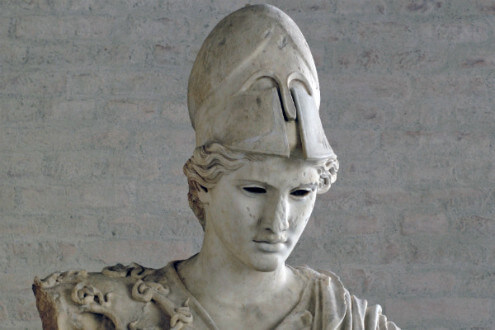
Athena - Minerva
- Athene is the Goddess of War and Wisdom.
- Athene’s tree, which she created, is the olive tree.
- Athene’s bird is the owl.
- Athene’s Roman name is Minerva.
Goddess of intelligence, war and the artworks, and most loved daughter of Zeus, Athena was, maybe, the smartest and most bold of the Olympian divine beings. She was often associated with a shield for war, the owl for wisdom or the olive tree.
She was also a patron of the agricultural arts and of the crafts of women, especially spinning and weaving. Athena had a prominent role in Homer’s epics the Iliad and the Odyssey, serving as Odyssey’s patron throughout his long voyage.
Legends say that Zeus had prevented a normal birth of a son with Athena’s abilities, who he feared to unseat him.
She is closely associated with Athens, the city named in her honour after the people of Attica chose her as their patron.
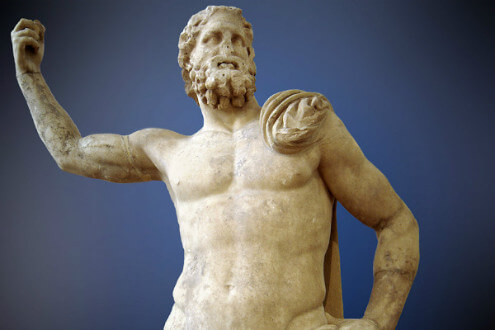
Poseidon - Neptune
- Poseidon is the ruler of the sea.
- Poseidon is credited with having created the horse.
- Poseidon’s Roman name is Neptune.
Poseidon was the third son of Kronos and the brother of Zeus and Hades. He was also known as the god of earthquakes and the god of horses.Despite sacrifices including drowned horses, he could cause storms, bad winds and earthquakes, at a whim.
Like Zeus, he projected his power and masculinity on women, fathering many children. In a famous contest between him and Athena to decide which of the two would be the patron god of Athens, he threw a spear into the ground to create the Spring of the Acropolis. He greatly aided the Greeks it the Trojan war, but took years of revenge on Odysseus, who had harmed one of Poseidon’s Cyclops offspring.
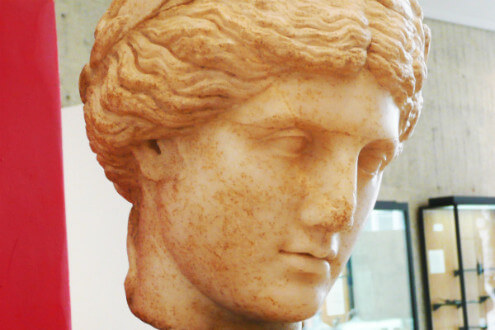
Apollo - Apollon
The golden-haired god of sun and light, (the light was symbolized by his golden arrows). Apollo was the god of music, play and golden lyre, as well as the protector of medicine and arts, foreteller, protector of flocks, roads, travelling and voyagers.
Apollon was embodying the sun, and his sister Artemis – the moon.
Son of Leto and Zeus, twin brother of Artemis, grandson of titans, Apollon was born on the rocky island of Delos, where his mother came, pursued by the jealous goddess Hera. When Apollon was born, the whole island was flooded with sunlight.
He had many children among them was Orpheus. Apollon was also the god who sent illness and death to people.
Among his victims were sons of Gods; he was punished with unshared love for the nymph Daphne, for mocking at Eros, the god of love.
Apollon was punished also by Zeus for killing the Cyclops, he was sent to serve a human (in another variant he was sent, for eight years as a shepherd to king Admet).
In spring and summer Apollon was staying in Delphi, and in the autumn he was flying in his chariot with white swans, to the place where the goddess Latona was born.
The attributes of Apollon: silver bow and golden arrows, golden lyre; his symbols: laurel, olive, palm tree, dolphin, swan and wolf.
The famous sacred places of Apollon are: the oracle at Delphi and Delos Island – his and Artemis birth place. Once in four years in Delos were held the holidays in Apollon’s honor (during this time all the wars and executions were forbidden).
The oracle at Delphi was famous all over the ancient world. It was founded in the place where Apollon defeated Pifon, the dragon who was pursuing his mother. In the oracle Pifona was foretelling the Zeus will.
God Apollo was son of Zeus and Leto, and twin brother to Goddess Artemis.
He was also known as the Archer-god, the Healer, the God of Light, and the God of Truth.
The Greek god of music playing a golden lyre. The Archer, far shooting with a silver bow. Apollo the Greek god of healing who taught man medicine. The Greek god of light. The Greek god of truth, who can not speak a lie.
He established the Oracle at Delphi when he rid the city of the dragon Python.Apollo dedicated a bronze tripod to the sanctuary there and bestowed divine powers on the priestess, Pythia.She would chew on laurel levels and inhale the the hallucinating vapors issuing from the temple floor, while mumbling prophecies that had to be translated by attendant male priest.Apollo is often shown as holding bow and arrow symbolizing the sun’s rays.
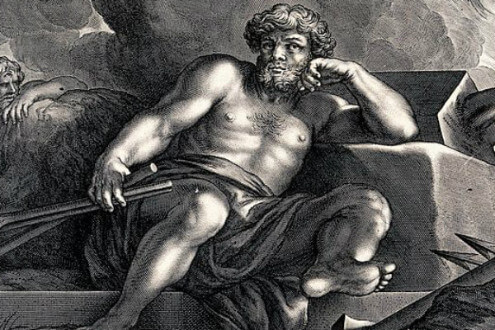
Hephaestus - Vulcan
- Hephaestus is the God of Fire.
- Hephaestus was originally an Asia Minor diety.
- Hephaestus’ Roman name is Vulcan.
The son of the Zeus and Hera, he was the god of fire, volcanoes, black smiths, metal working, he had a strong following in the cities where his skills were important to commerce and war.
He was usually seen with an axe. In one account he sided with his mother Hera against Zeus who threw him so far that he fell all day and limped thereafter. Hephaestus was associated with mountain Etna on the island of Sicily. In his workshop he fashioned many wondrous things for the gods, including thunderbolts for Zeus, Athena’s shield Aegis, arrows for Eros, and the chariot with which Helios the sun god rode across the sky. He also made weapons for other gods and even for some human heroes (armor of Achilles).
He helped create the first human woman from clay, named Pandora, who released the evils of the world on humankind from her magic jar.
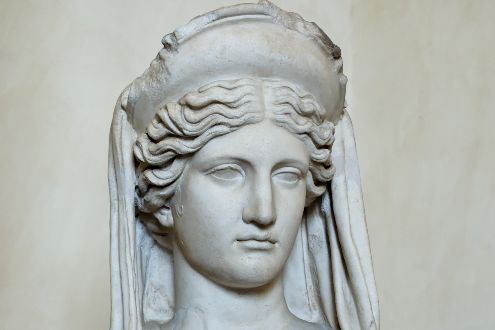
Demeter - Ceres
- Demeter’s name means “mother earth.”
- Demeter is the Goddess of the Harvest.
- Demeter’s Roman name is Ceres.
Demeter, daughter of Cronos and Rhea, whom the Romans identified with their Ceres, was the goddess of agriculture, one of the greatest and most revered deities.
Demeter, was the goddess of the fields and crops, in Greek it meant “mother Earth”. Like all peasants she had a simple character, of unexceptionable morality. She was worshiped as a benign and affectionate mother. She protected all agricultural products, but especially those considered most important, fodder and cereals.
Her cult was widespread in Thessaly, in Boeotia, in Attica, in Corinth and throughout the Peloponnese up to Sicily. She had a daughter with Zeus, Persephone. Demeter was depicted as a severe and majestic matron, but also beautiful and affable, with a crown of ears on her head, a torch in one hand and in the other a fruit basket.
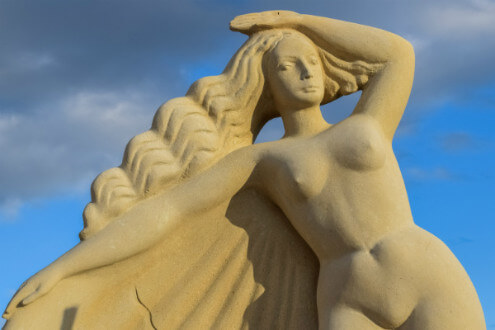
Aphrodite - Venus
Her role as the goddess of love was to make love and inspire others to so as well.
Aphrodite is one of the most famous Greek goddesses, namely goddess of love, beauty and sensual desire. According to the poet Homer, she is the daughter of Dione and Zeus. According to Hesiod she is the daughter of Uranos, one of the pre-olympic gods. She is usually shown naked and is equipped with myrtle, apple, rose, shell, pigeon or belt.
She is also one of the canonical twelve Olympian deities. Before she rose to the love goddess she was responsible for the growth and emergence.
Her counterpart in Roman mythology is Venus. In addition to its importance in becoming an “Aphrodite Persephasse” (Persephone), Aphrodite also possesses the aspect of being a destroyer or war goddess.
The husband by her side was Hephaestus, the god of fire and blacksmithing. Loyalty was not so important to her because she constantly cheated Hephaestus with mortals and immortals. Their long relationship with the god of war, Ares, is worth mentioning, for it gave birth to Eros, Harmonia, Phobos, Deimos and Anteros. Among her constant companions were the Charites as well as Eros and Peitho.
This myth, to which it owes its nickname “the foam-born”, was constructed from the Greek word aphros (foam). Cults around Aphrodite probably existed long before the heyday of the Olympian gods.
Symbols & Attributes
The goddess is often associated with animals. She is also the goddess of flowers, trees and fruits.
Many plants that have a psychoactive or erotic effect, an intense fragrance or a symbolic form have been associated with Aphrodite (aphrodisiacs) and used in their festivals. In Cyprus, Samos and Crete, as well as Athens and Kephisos, she owned sacred groves and flower gardens.
Aspects & Manifestations
Aphrodite has numerous multifarious manifestations and epithets. Originally Aphrodite was probably a mother and fertility goddess – goddess of growth and emergence. By attributing to nature a yearning desire, it became the goddess of love and gradually of beauty.
It seems that the origin of their worship is already falling back into the epoch in which the Greeks still formed a unity with the other Indo-European peoples; for we find among the majority of these peoples a godlike being of their kind. But this original shape has been heavily blurred on the islands and the mainland of Greece by Oriental, especially Near-Asian and Phoenician, influences.
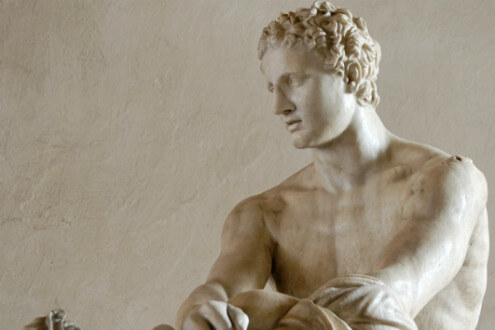
Ares - Άρης - Mars
Greek god of war
Ares the god of the terrible war, the bloodbath and the massacre. He is the son of Hera and Zeus and is usually depicted with a spear, shield and helmet and accompanied by a vulture or a dog. He is the father of Phobos and Deimos.
Ares is described as a raw, savage, indestructible war god, who enjoys violence and moves with the wild animals to feed on their blood. Ares is uncouth and wild. With his burning torch, wild dogs and vultures, accompanied by his sons Phobos (fear) and Deimos (horror) he goes to battle. He is aggressive, cruel, merciless and bloodthirsty, often interfering actively in the battles and sending unfortunate mortals to their deaths.
During the Trojan War, he fought on the side of the Trojans, triumphed and drove one victory after another, but is hit by a spear and had to leave the battlefield prematurely.
Nothing gives him so much pleasure as strife, looting and massacres.
Although Ares was hated as a god of war by gods and men – even his father Zeus despised him – he was also, on the embodiment of men’s warcraft, as a symbol of male strength and beauty. Mythologically, this is symbolized in his love affair with the love goddess Aphrodite.
Ares – lover of Aphrodite
Ares, God of Power, is loved by the most beautiful of the beautiful, the goddess of love. Ares is not only one of Aphrodite’s many lovers, but her darling. At least three children give birth to him.
Common sons and daughters of Ares and Aphrodite
Anteros, the god of spurned, unrequited love
Harmonia, the goddess of harmony
Deimos, the god of horror
Phobos, the god of fear
Enyalios, the god of struggle
Sometimes also: Eros, the god of love
He had both male and female lovers, including: Aphrodite (goddess of beauty and love), Eos (goddess of the dawn), Eris (goddess of envy and discord) and countless female and male mortals.
Allies
His allies include Hades, the underworld ruler, Ker (goddess of violent death), Ate (goddess of delusion), Deimos (god of horror), Phobos, Enyalios (god of struggle) and Eris (goddess of envy and discord).
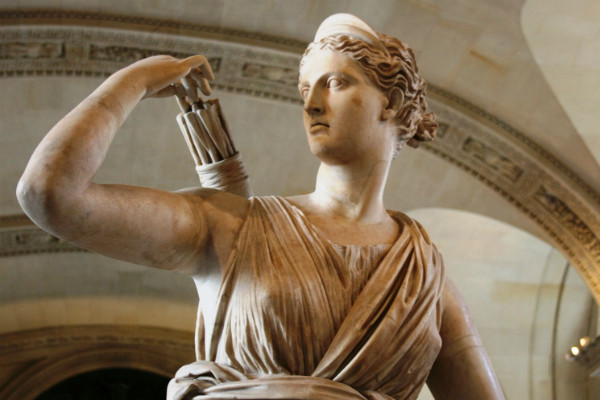
Artemis - Diana
Artemis was one of the twelve great deities in Greek mythology, the goddess of hunting, growth and birth, and at the same time the protector of the weak and children. She is the daughter of Leto and Zeus and the twin sister of Apollon, at whose birth, she is said to have helped Leto.
She wears quiver, bow and arrow. Artemis is often depicted with a doe and a crescent moon.
She was a moon goddess to the Amazons. The Romans equate them with Diana. Her statue in Ephesus exposes her covered with breasts (according to another interpretation, it is the bull’s testicles), which she embodies as a provider of all living things. On the other hand, her name in Sparta was “Artamis”, which means “butcher”.
The neo-temporal Artemis seems to have been a bloodthirsty goddess. In Hierapolis, men were sacrificed by hanging at the Artemis Temple. In Attica, Artemis was soothed by symbolic beheadings (in which the neck of a man was scratched with the sacrificial sword until blood flowed). By contrast, Ephesus’ “many-breasted” Artemis was the patron of nutrition, fertility and childbirth.
Birth
The legend about her birth is very remarkable: the highly pregnant goddess Letho found no place for her childbirth. Eventually, Athena and many other Olympian goddesses helped her out as midwives. But only when Hera agreed, the birth goddess Eileithyia could be called for help. Leto first gave birth to the female Moon in the form of Artemis. This then helped the mother immediately at the birth of her twin brother, the male sun in the form of Apollo. Thus, Artemis is also the goddess of obstetrics and midwives. The birthday of Artemis and Apollon was celebrated on the 6th and 7th day of the Attic-Ionian month Thargeliṓn (late April to late May) in ancient Greece. If Apollon was equated with the sun god, Artemis was the corresponding moon goddess.
Artemis also became the goddess of the spell, the sorceresses and witches, and the magic herbs.
She is especially responsible for women, virginity, initiation, marriage and childbirth.
The killing of the Niobides
Artemis is surrounded by many cruel and less cruel legends, such as the killing of Niobides, the children of Niobe. Queen Niobe had 14 children, 7 boys and 7 girls – the niobides and tried to persuade the people to make no sacrifices to the goddess Leto. This angered the goddess and also her children, so that Artemis and Apollon moved out to kill the niobides with a bow and arrow. Apollon killed the 7 boys, Artemis the girls (a motif of numerous ancient sculptures). Then they turned their mother Niobe into a rock that was about to shed tears.
Artemis and Orion
As a moon goddess and a passionate huntress – that is why she is depicted with a bow and arrow – she steered the moon across the sky, but always went hunting at new moon. When she became friends with Orion, the magnificent and wild hunter, she should have neglected her duties as the moon goddess to meet him in the dark. Apollon was angry about it and challenged Artemis to the competition: She certainly would not succeed in hitting a dark spot far out in the sea with her arrow. Artemis did that very well – and realized too late that she had pierced with it the head of the floating Orion. Therefore, she raised him as a constellation in the sky. However, another narration reports that Orion had tried to rape the virgin Artemis, after which she had killed him.
Yet another story sees Orion as the hunter who wanted to kill all the wild animals. The earth, or Artemis itself, then produced a scorpion that Orion could not do anything about and eventually killed him, after which both were sent to heaven as a constellation.
Battle of the giants
In the fight against the giants Artemis killed Tityos, who had tried to rape Leto.
Aftermath
The New Testament mentions the Temple of Artemis in Ephesus, one of the Seven Wonders of the World. It is noteworthy that in Ephesus Cyril of Alexandria, the land of the goddess Isis, popular throughout Europe, at the Council of Ephesus enforced the veneration of Mary as the Mother of God, which was the beginning of the Christian cult of Mary.
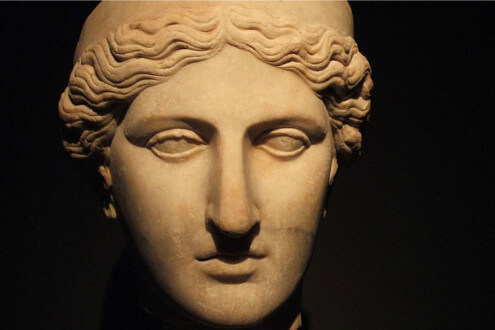
Hera - Ήρα - Juno
Hera (Ήρα) is the wife of Zeus in Greek mythology.
Pre-Hellenic Great Goddess, Greek Queen of Heaven, supreme Olympic Mother Goddess
Hera is the goddess of the earth and its inhabitants, especially women and their sexuality. Mistress of the births, creator, mother of all goddesses, guardian of paradise, the “apple country”.
Long before Zeus was known in Greece, the people of the Aegean revered a cow-eyed Queen of Heaven as the supreme deity they called Hera. She is originally a Cretan goddess. Heraklion, the capital of Crete, is named after her.
The Cretan Hera is in the guise of a girl the goddess of the mountains and the mistress of the wild animals. Griffins, sphinxes and winged genii are their companions, but above all the lion, their great protector. Hera was always present because she was worshiped in every house on Crete in the guise of a living snake.
THE THREE DIVINE LIFE
When looking at the figure of Hera, one should always distinguish between the ancient Cretan, pre-Hellenic and the Olympian goddess. In any case, Hera is a Great Goddess who is worshiped in her three aspects as the virgin Hebe, the motherly Hera, and the aged Hecate. In another version of the Triple Goddess, Hera is the daughter with Rheia as a mother and Gaia as a grandmother.
Like mortal women, Hera goes through three stages of life: youth, maturity, and age. As Hebe, she is also referred to as “the virgin”. Hera is the symbol of the flowering of human youth, as well as the budding earth. Secondly, Hera is the mature woman who is also called Nymphoeuomene: “One Companion Seeker,” or Teilia: “The Perfect One.” Finally, she is called Hekate or Cheira or Theira, the “old woman”, the “wise old woman”, the old woman, the “grandmother”.
After she has gone through motherhood and left it behind, the noble prophetic way now lives on its own again. These great periods of Hera’s life also stand for shorter cycles such as the crescent moon, full moon and new moon or spring, summer and fall.
THE GREAT SPORT FESTIVAL OF THE HERA
In honor of these three phases of Hera, people in ancient Greece celebrated a great festival – the “Heraia” named after them, whose origins go further back than the Olympics.
Every four years, women gathered in a field near Heras, Argos, to compete in 150 meter runs. They ran with bare breasts and blowing hair. The run led to harvested fields and reflected the universal cycles of the annual cycle. This was known in some areas of Western Europe in the last century as “stubble runs” or “shepherd indoor runs”.
These Heraia were part of a larger goddess service and were targeted by 16 women. There were three age groups and three winners in the Heraia. Each received a crown of olive branches and a portion of the cow that was the victim at this sports festival.
The three winners, a young girl, a mature and an old woman, were allowed to put a statuette in Hera’s shrine. In the years between these Heraia the big Olympic Games were later established, in which only men took part.
The Heraia festival took place on the new moon at the beginning of the month Parthenios, in a matriarchal constellation of the festival of night and new moon, in contrast to the later patriarchal games, for the day and full moon prevailed.
RECOVERY OF YOUNG TEMPERANCE THROUGH SOURCE BATH
Hera goes through – as all women – again and again all these cycles and renews herself annually in the bath in a sacred spring, in which she always regains her virginity (see also snake goddess).
On the occasion of this annual renewal, the goddess’s figurine was brought out of her shrine and brought to the water with great ceremony. Through the bath of her portrait, the winter was washed away, her youth revived and prepared for the new seasonal cycle of maturity and death. It was a symbol of the eternal rebirth of the earth and with it the rebirth of the people.
In ancient Greece, a distinction was made between the four stages of life. First the time as a child, followed by the youth, then the time of adulthood (usually associated with the founding and maintenance of a family) and finally the age.
Hera stands for all these sections in the life of a woman and is therefore also known by the nickname Pais (= girl), Nympheuomene (= bride), Teleia (= adult) and Khera (= widow) called. The Olympic goddess Hera is described as the daughter of Kronos and the Rheia. She is the sister of Demeter, Hades, Hestia, Poseidon, and Zeus, whose wife she was.
Both children were the war god Ares, the goddess of youth Hebe and the birth goddess Eileithyia. Her son Hephaestus was born without Zeus, he jumped from her hip.
The Relationship of Zeus and Hera
Originally, Hera had no companion. But when the patriarchal tribes invaded Greece, they brought the god of heaven, Zeus, with them. Because the belief in the Mother Goddess was too strong for her to be destroyed, a marriage of convenience was forged between the two prevailing deities. At first, however, Hera did not want this marriage at all.
REPRESENTATIVE OF THE MOTHER RIGHT
It can be surmised that the constant arguments between Hera and Zeus reflect the friction between the early patriarchal and matriarchal cults. Although her marriage came about under the circumstances, she confidently went into it, insisting on her rights and avoiding conflicts. The quarrelsome character can also be considered quite positive. Hera, as a representative of the ancient maternal law, is the protector of the family. On Crete, where Hera originally came from, she was the protector of the home and the family. She protected the house and stove, just like Hestia later. She was thus the goddess of culinary arts, but she was also the goddess of agriculture, olive growing, wine culture, pottery, weaving, silver-Blacksmithing, the production of medicines and medicine, the sciences of weighing, measuring and counting, On the other hand, she took care of all the girls and young women of her country. For girls and young women, for example, there were the previously mentioned “Heraia” competitions, which were held every four years in their honor and had a cultic connection.
FROM THE MATRIARCHAL SUPPORTER TO THE MARRIAGE PROTECTOR
The matriarchal protector and promoter role of Hera was later strangely reinterpreted as the “Protector of Marriage,” a life form that does not fit the nature of this goddess. For better and for worse, she is at the mercy of her husband.
HERA AND THE HEROES
Hera’s sacred animal was the cow. She is also called the cow-eyed one, which is a special compliment to her beautiful eyes. Only those who sucked milk from the breasts of Heras could become immortal.
When Zeus cunningly lays one of his illegitimate sons to her breast, the boy greedily sucks and bites with all his might. Hera wakes up screaming and pushes off the pushed baby. The milk splashes across the sky in a high arc and creates the Milky Way.
The boy was then called Heracles, “the one who acquired glory of Hera”. Often, Hera has also been considered as the air that is between Earth and Ether (then Zeus).
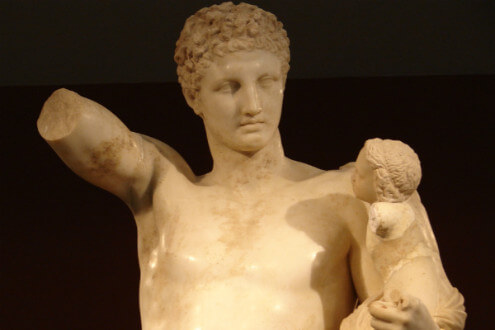
Hermes - Mercury
Greek god of magicians and merchants
Hermes is in the Greek mythology the messenger of the gods, on the one hand the patron god of the ways, the traffic, the wanderers, the merchants and the shepherds, but on the other hand god of the thieves, the rhetoric, the gymnastics and the magic. He is the son of Zeus and Maia; the messenger of the gods, who directs the message of the gods to the mortals. He is also the inventor of the lyre. He gave the lyre to his godly brother Apollon. He is usually depicted with a winged helmet or winged shoes. In Roman mythology, Hermes was equated with Mercury, in Egyptian mythology with Thoth.
Tasks, signs and name of Hermes
A God with so many tasks just has to be smart. List of his tasks:
Guardian god of traffic and travelers
Messenger of the gods. As such, Hermes announces above all the decisions of Zeus. And he leads the dead to the river of oblivion – the entrance of the underworld.
God of merchants
God of the shepherds
God of science
God of the Magicians (Hermetic Wisdom, Alchemy)
God the thieves
God of the rhetoric
God of sleep and dreams
Signs that are typical for Hermes:
Cairn, the Hermes trail marker
Travel hat, in various variants
Caduseus – the caduceus, a walking stick that also served as a magic wand
Wing shoes.
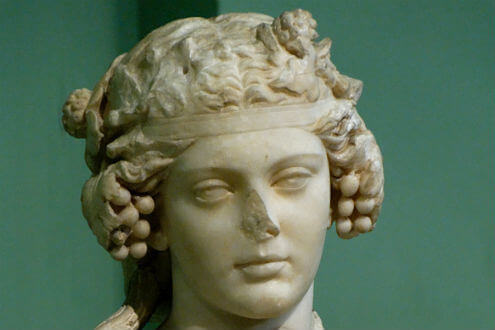
Dionysus - Bacchus
God of wine and ecstasy. His father is Zeus, his mother is either Demeter, Io, Persephone, Lethe or Mortal Lethe. Dionysus was later added to the Olympus and is presented with grapevines, grapes and a panther or deer skin. He is the youngest of the great Greek gods.
He is considered the youngest of the Greek gods and represents the ecstatic form of spirituality. There is sometimes the dualism or polarity of Dionysus and Apollo. Apollon represents civilized, cultivated spirituality or high spirituality. Dionysus stands for the untamed spirituality, the ecstasy, the supernatural with dance and mind-altering drugs.
He was usually accompanied by the Silene and Satyrs, who embody the fertility of untamed nature. He was especially worshiped by women, the Maenads. They were wreathed with ivy, wrapped in stag or deerskin, and carried torches and thyrsoi (ivy-wreathed rods of nardhex, a pine cone on top, also called “Bacchus stick”). In their orgiastic rites wild animals were torn and eaten and enjoyed “free love” between the sexes. They danced accompanied by flutes, timpani and tambourines.
His animal form was the bull, which connects him with his father Zeus.
In human form, Dionysus was ritually portrayed as a bearded mask. His mask hangs on a pole or column, including a long robe.
During the winter absence of Apollo, Dionysus supervised the oracle of Delphi.
Stories about Dionysus birth and childhood
As with many deities, different stories are told about the origin of Dionysus, from different regions and different times. To assume that these are two separate mythological personalities, Dionysos Zagreus and a better known Dionysus, “god of wine”.
Dionysus (Latin Bacchus), son of Semele and Zeus, is the god of wine and fertility, the god of instinct and awakening nature. He was nursed after his birth by Ino, the sister of Semele, or by nymphs of Nysa.
From the cult song of Dionysus, the Dithyranbos, the drama has developed. In Rome there was as a similar cult the bacchanalia.
Dionysos Zagreus
The songs told the story of Dionysos Zagreus. Zeus approached in a cave of his daughter, the underworld goddess Persephone, as a serpent. Her child was known as Zagreus, the “great hunter,” which epithet also Zeus himself carries as an underworld god, especially in Crete. Dionysus, son of Persephone, was also called Chtonios, “subterranean”.

